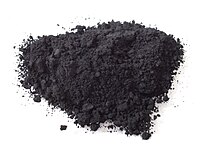
Photo from wikipedia
While cobalt (Co) stands out as the most effective non-precious metal for activating monopersulfate (MPS) to degrade organic pollutants, Co nanoparticles (NPs) are easily aggregated, losing their activities. As many… Click to show full abstract
While cobalt (Co) stands out as the most effective non-precious metal for activating monopersulfate (MPS) to degrade organic pollutants, Co nanoparticles (NPs) are easily aggregated, losing their activities. As many efforts have attempted to immobilize Co NPs on supports/substrates to minimize the aggregation issue, recently hollow-structured carbon-based materials (HSCMs) have been regarded as promising supports owing to their distinct physical and chemical properties. Herein, in this study, a special HSCM is developed by using a special type of ZIF (i.e., ZIF-L) as a precursor. Through one-step chemical etching with tannic acid (TA), the resultant product still remains leaf-like morphology of pristine ZIF-L but the inner part of this product becomes hollow, which is subsequently transformed to ultrafine Co-NP embedded hollow-structured N-doped carbon (CoHNC) via pyrolysis. Interestingly, CoHNC exhibits superior catalytic activities than CoNC (without hollow structure) and the commercial Co3O4 NPs for activating MPS to degrade phenol. The Ea value of phenol degradation by CoHNC + MPS was determined as 44.3 kJ/mol. Besides, CoHNC is also capable of effectively activating MPS to degrade phenol over multiple-cycles without any significant changes of catalytic activities, indicating that CoHNC is a promising heterogeneous catalyst for activating MPS to degrade organic pollutants in water.
Journal Title: Journal of colloid and interface science
Year Published: 2021
Link to full text (if available)
Share on Social Media: Sign Up to like & get
recommendations!